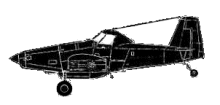
ASN Wikibase Occurrence # 298155
This information is added by users of ASN. Neither ASN nor the Flight Safety Foundation are responsible for the completeness or correctness of this information.
If you feel this information is incomplete or incorrect, you can submit corrected information.
| Date: | Tuesday 18 July 2017 |
| Time: | 16:10 LT |
| Type: |  Air Tractor AT802 |
| Owner/operator: | C |
| Registration: | N816FF |
| MSN: | 802A-0714 |
| Year of manufacture: | 2017 |
| Total airframe hrs: | 8 hours |
| Engine model: | Pratt & Whitney Canada PT6A-65AG |
| Fatalities: | Fatalities: 0 / Occupants: 1 |
| Aircraft damage: | Substantial |
| Category: | Accident |
| Location: | Reyno, Arkansas -
 United States of America United States of America
|
| Phase: | Landing |
| Nature: | Agricultural |
| Departure airport: | Reyno, AR (KPVT) |
| Reyno, AR | |
| Investigating agency: | NTSB |
| Confidence Rating: |
The pilot was returning to the landing strip after an uneventful spray flight when he noticed a rapid increase in engine torque shortly after he made a power reduction. The pilot stated that he 'looked at my levers and pushed the prop lever all the way forward.†According to the pilot, there was insufficient thrust to maintain altitude and he made a forced landing in an open field. The airplane's left wing impacted the ground during landing and the airplane skidded sideways to a stop. The right wingtip, right aileron, and right elevator were substantially damaged.
Examination and bench testing revealed no evidence of a mechanical malfunction or failure that would have precluded normal engine operation. Engine control continuity was confirmed from the cockpit levers to their respective engine components, and the engine controls moved smoothly through their full range of motion.
An analysis of the airplane's engine monitor data revealed that the pilot had mistakenly moved the cockpit propeller lever instead of the power lever while he maneuvered to land. When the pilot moved the propeller control aft it increased propeller pitch which, in turn, decreased propeller speed (Np). As Np decreased there was a corresponding increase in engine torque. The data analysis revealed that Np decreased to the point where the constant speed unit (CSU) feather valve dumped oil pressure, and the propeller feathered. Engine torque then rapidly increased above the 5,100 ft-lbs limitation. Shortly after the propeller feathered, there was a rapid increase in fuel flow and engine torque, consistent with the pilot moving the power lever full forward with the propeller still feathered. The gas generator speed (Ng) and fuel flow remained relatively constant and the engine torque remained above 6,600 ft-lbs until the engine was shut down after the accident.
Probable Cause: The pilot's inadvertent use of the propeller control, which caused the propeller to feather while in flight with the engine still operating, resulting in a loss of thrust and a subsequent forced landing.
Accident investigation:
 |
|
Sources:
NTSB CEN17LA284
Location
Revision history:
| Date/time | Contributor | Updates |
|---|---|---|
| 15-Oct-2022 13:48 | ASN Update Bot | Added |
Corrections or additions? ... Edit this accident description
The Aviation Safety Network is an exclusive service provided by:


 ©2024 Flight Safety Foundation
©2024 Flight Safety Foundation